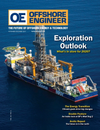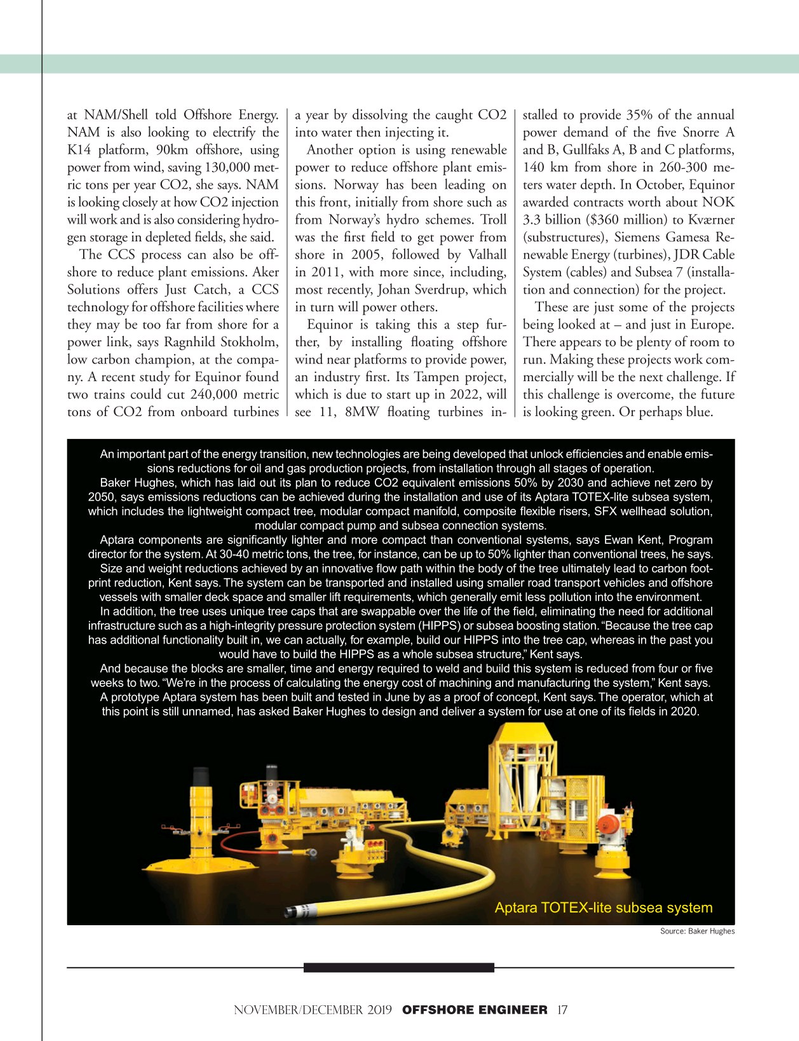
Page 17: of Offshore Engineer Magazine (Nov/Dec 2019)
Exploration Outlook
Read this page in Pdf, Flash or Html5 edition of Nov/Dec 2019 Offshore Engineer Magazine
at NAM/Shell told Offshore Energy. a year by dissolving the caught CO2 stalled to provide 35% of the annual
NAM is also looking to electrify the into water then injecting it. power demand of the ? ve Snorre A
K14 platform, 90km offshore, using Another option is using renewable and B, Gullfaks A, B and C platforms, power from wind, saving 130,000 met- power to reduce offshore plant emis- 140 km from shore in 260-300 me- ric tons per year CO2, she says. NAM sions. Norway has been leading on ters water depth. In October, Equinor is looking closely at how CO2 injection this front, initially from shore such as awarded contracts worth about NOK will work and is also considering hydro- from Norway’s hydro schemes. Troll 3.3 billion ($360 million) to Kværner gen storage in depleted ? elds, she said. was the ? rst ? eld to get power from (substructures), Siemens Gamesa Re-
The CCS process can also be off- shore in 2005, followed by Valhall newable Energy (turbines), JDR Cable shore to reduce plant emissions. Aker in 2011, with more since, including, System (cables) and Subsea 7 (installa-
Solutions offers Just Catch, a CCS most recently, Johan Sverdrup, which tion and connection) for the project. technology for offshore facilities where in turn will power others. These are just some of the projects they may be too far from shore for a Equinor is taking this a step fur- being looked at – and just in Europe. power link, says Ragnhild Stokholm, ther, by installing ? oating offshore There appears to be plenty of room to low carbon champion, at the compa- wind near platforms to provide power, run. Making these projects work com- ny. A recent study for Equinor found an industry ? rst. Its Tampen project, mercially will be the next challenge. If two trains could cut 240,000 metric which is due to start up in 2022, will this challenge is overcome, the future tons of CO2 from onboard turbines see 11, 8MW ? oating turbines in- is looking green. Or perhaps blue.
An important part of the energy transition, new technologies are being developed that unlock ef? ciencies and enable emis- sions reductions for oil and gas production projects, from installation through all stages of operation.
Baker Hughes, which has laid out its plan to reduce CO2 equivalent emissions 50% by 2030 and achieve net zero by 2050, says emissions reductions can be achieved during the installation and use of its Aptara TOTEX-lite subsea system, which includes the lightweight compact tree, modular compact manifold, composite ? exible risers, SFX wellhead solution, modular compact pump and subsea connection systems.
Aptara components are signi? cantly lighter and more compact than conventional systems, says Ewan Kent, Program director for the system. At 30-40 metric tons, the tree, for instance, can be up to 50% lighter than conventional trees, he says.
Size and weight reductions achieved by an innovative ? ow path within the body of the tree ultimately lead to carbon foot- print reduction, Kent says. The system can be transported and installed using smaller road transport vehicles and offshore vessels with smaller deck space and smaller lift requirements, which generally emit less pollution into the environment.
In addition, the tree uses unique tree caps that are swappable over the life of the ? eld, eliminating the need for additional infrastructure such as a high-integrity pressure protection system (HIPPS) or subsea boosting station. “Because the tree cap has additional functionality built in, we can actually, for example, build our HIPPS into the tree cap, whereas in the past you would have to build the HIPPS as a whole subsea structure,” Kent says.
And because the blocks are smaller, time and energy required to weld and build this system is reduced from four or ? ve weeks to two. “We’re in the process of calculating the energy cost of machining and manufacturing the system,” Kent says.
A prototype Aptara system has been built and tested in June by as a proof of concept, Kent says. The operator, which at this point is still unnamed, has asked Baker Hughes to design and deliver a system for use at one of its ? elds in 2020.
Aptara TOTEX-lite subsea system
Source: Baker Hughes
NOVEMBER/DECEMBER 2019 OFFSHORE ENGINEER 17

 16
16

 18
18